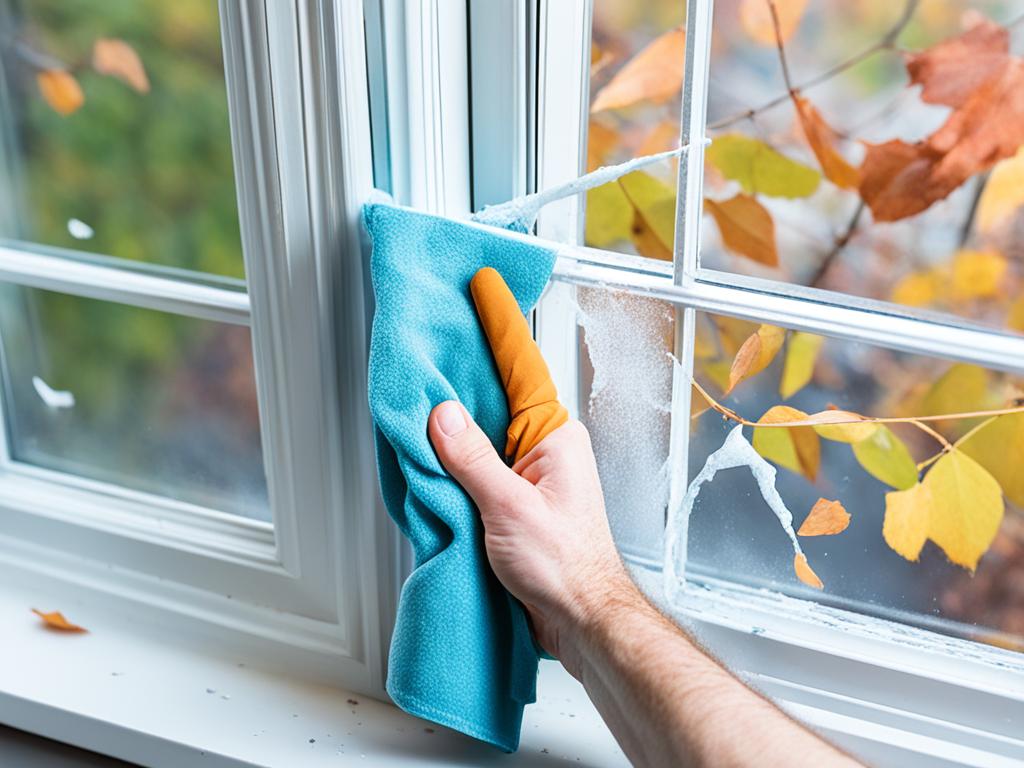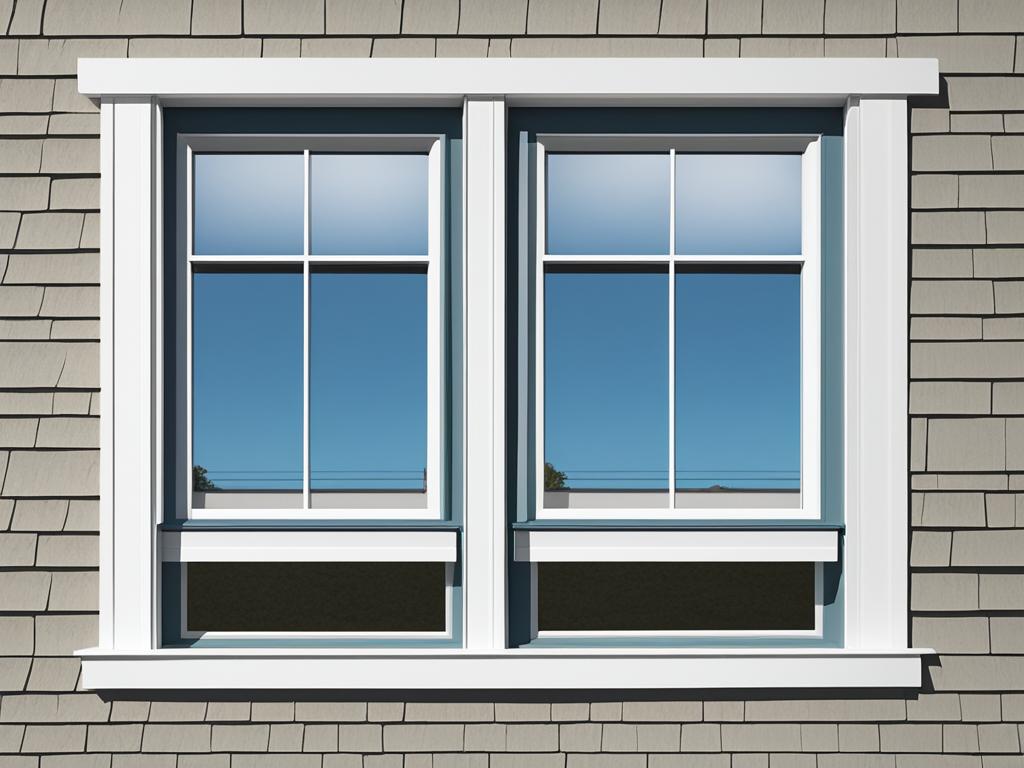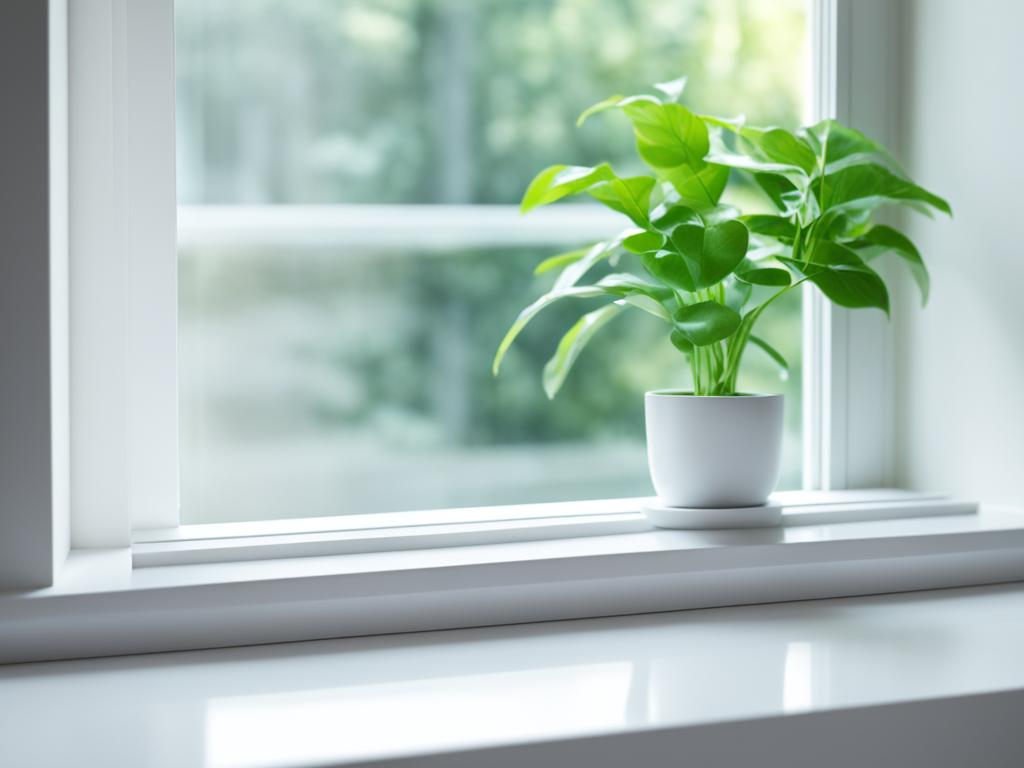Window sills are not only functional but also add a touch of elegance to your home’s interior and exterior. Two popular options for window sills are lipped and flat sills. Each type has its own advantages and considerations, making it important to understand the differences before making a decision.
Key Takeaways:
- Lipped window sills are easy to install and come in various colors, offering better long-term value.
- Flat window sills require more maintenance and may not provide the same visual appeal as lipped sills.
- Material selection is crucial to prevent issues like rot and mold growth.
- Materials options range from wood to PVC to stone, each with its own pros and cons.
- Consider the style, architectural details, and your lifestyle when choosing a window sill material.
Different Window Sill Materials and Their Pros and Cons
When it comes to window sills, there are various materials to choose from, each offering its own set of advantages and drawbacks. Understanding these differences can help you make an informed decision based on your style preferences, architectural details, and lifestyle.
Wood Window Sill
Wood sills provide a traditional and timeless look that can add warmth and character to your home’s interior. They are often favored for their natural beauty and versatility in design. However, wooden sills require regular upkeep, including painting or sealing, to protect against moisture damage and maintain their appearance over time.
PVC Window Sill
PVC (polyvinyl chloride) and plastic window sills have gained popularity due to their affordability and low maintenance. They are resistant to rot, warping, and insect damage, making them a durable option. However, PVC sills may lack the strength and natural aesthetic of wood, limiting the design possibilities.
Ceramic Tile Window Sill
Ceramic tile sills offer a sleek and modern look, with a wide range of colors and patterns to choose from. They are known for their durability and resistance to moisture. However, ceramic tiles can be expensive to install and prone to staining, requiring regular cleaning and maintenance to keep them looking their best.
Stone Window Sill
Stone sills, such as granite or marble, provide a luxurious and elegant touch to any window. They are extremely durable and can withstand the test of time. Stone sills are less common and can be more expensive than other options, but their natural beauty and durability make them a worthwhile investment for those seeking a high-end look.
When selecting a window sill material, weigh the pros and cons carefully to find the perfect balance between aesthetics, durability, and maintenance requirements.
Installation and Maintenance of Window Sills
Window sills play a vital role in protecting your home’s exterior walls from water damage. Whether you are installing a new window sill or replacing an old one, proper installation and regular maintenance are essential for long-term durability and aesthetic appeal.
Selecting the Right Materials
When it comes to window sill materials, there are several options available, including wood, PVC, stone, and more. Consider the style of your home and the level of maintenance you are willing to undertake.
Tip: For wood sills, select high-quality, select-grade wood that is resistant to rot and moisture. Ensure your wood sill is properly sealed or painted for enhanced weather protection.
Tools for Installing Window Sill
Before you begin the installation process, make sure you have the necessary tools on hand. Here are some tools commonly used for window sill installation:
- Saw (circular saw or miter saw)
- Measuring tape
- Screwdriver
- Level
- Hammer
- Drill
Window Sill Installation
The installation process may vary depending on the type of window and sill you have. However, the general steps involve measuring, cutting, and securing the sill in place. It is crucial to follow the manufacturer’s instructions or consult a professional if you are unsure.
Adding an Apron to the Sill
Enhance the appearance of your window sill by adding an apron. An apron is a decorative trim that extends below the window sill. It can be made from the same material as the sill and adds a touch of elegance to your windows.
Window Sill Maintenance
Maintaining your window sill is essential to prolong its lifespan and keep it looking its best. Here are some maintenance tips:
- Regularly clean your window sill to remove dust, debris, and moisture that can lead to mold or rot.
- Inspect your window sill for any signs of damage, such as cracks or water damage, and repair them promptly.
- Consider hiring professionals for more thorough maintenance, such as sealing or repainting the wood sill.

Proper installation and regular maintenance of your window sills are crucial to their functionality and longevity. By selecting the right materials, using the necessary tools, and following best practices, you can ensure that your window sills not only protect your home but also add beauty and charm to your windows.
Understanding Sloped Sills vs Pocket Sills
When choosing the right windows for your home, it’s essential to consider the type of sill that will best suit your needs. In this section, we’ll explore the differences between sloped sills and pocket sills, and why sloped sills offer numerous benefits.
Sloped sills have a straightforward design, typically made of vinyl or aluminum, with a gentle slope that allows water to drain away efficiently. This effective drainage system prevents water from accumulating and causing potential issues like leaks or structural erosion.
Pocket sills, on the other hand, have a more complex design with chambers that can collect dirt and standing water. This can lead to blockages and the potential for water damage if not regularly maintained.
The superior drainage capabilities of sloped sills make them easier to maintain and more resilient against water-related problems. By directing water away from the window, sloped sills minimize the risk of moisture intrusion and protect the structural integrity of your home.
Another advantage of sloped sills is their ability to enhance air infiltration. The slope creates a natural flow of air, allowing for better ventilation and improved energy efficiency. Additionally, the design of sloped sills allows for larger glass area, maximizing natural light and providing an unobstructed view.
Key Benefits of Sloped Sills:
- Efficient drainage system prevents water accumulation and structural erosion.
- Minimizes the risk of leaks and water-related damage.
- Enhances air infiltration for improved ventilation and energy efficiency.
- Offers a larger glass area, maximizing natural light and outdoor views.
To get a better understanding of the differences between sloped sills and pocket sills, take a look at the comparison table below:
| Sloped Sills | Pocket Sills |
|---|---|
| Simple design with efficient water drainage | Complex design with chambers that can collect dirt and water |
| Easier maintenance and better protection against water damage | Require regular maintenance to prevent blockages and potential water damage |
| Enhanced air infiltration for improved ventilation | Potential for decreased ventilation if not properly maintained |
| Maximizes glass area for better natural light and views | May have smaller glass area due to chamber design |

In conclusion, the choice between sloped sills and pocket sills is clear. Sloped sills offer superior drainage capabilities, easier maintenance, and enhanced air infiltration, all of which contribute to a more efficient and durable window system. With their ability to prevent water accumulation and provide larger glass area, sloped sills are an excellent choice for homeowners seeking both functionality and aesthetics.
The Importance of Window Sills
Window sills are not just decorative elements; they serve multiple important functions in a home. From providing structural integrity to improving energy efficiency, window sills play a vital role in maintaining the overall functionality and aesthetics of windows.
One of the primary purposes of a window sill is to protect the window, walls, and floors from water damage. Without a properly installed window sill, water can seep into the interior, causing structural issues and potentially leading to mold growth. The window sill acts as a barrier, redirecting water away from the window and preventing it from infiltrating the surrounding areas.
In addition to water protection, window sills contribute to the structural integrity of the window system. They help support the window frame and hold the window sash in place when closed, ensuring a secure fit and preventing air leakage. This not only enhances the window’s performance but also improves energy efficiency by minimizing drafts and heat loss.
Window sills also provide an opportunity for decorative space in your home. They can be utilized to display plants, ornaments, or other decorative items, adding a personal touch and enhancing the overall ambiance of the room. Whether you have a lipped window sill or a flat one, it can serve as a unique focal point to showcase your creativity and style.
Window sills are more than just surface-level decorations; they are foundational components that contribute to both the functionality and aesthetics of windows. Their purpose extends beyond visual appeal, encompassing protection against water damage, structural stability, improved energy efficiency, and the creation of a decorative space to personalize your home.

| Function | Benefits |
|---|---|
| Protection against water damage | Prevents water infiltration and potential structural issues |
| Structural integrity | Supports the window frame and holds window sash in place for a secure fit |
| Improved energy efficiency | Minimizes drafts and heat loss, reducing energy consumption |
| Decorative space | Allows for personalization and display of plants or decorations |
Replacing a Window Sill and Customization Options
Replacing a window sill can be a fulfilling and cost-effective DIY project, provided you have the right tools and follow the proper procedures. Whether you’re looking to replace a worn-out sill or upgrade to a more stylish option, there are various materials to choose from.
If you prefer a classic and warm look, wooden window sills are a popular choice. However, keep in mind that wood requires regular painting or sealing to protect it from weather damage. On the other hand, stone window sills offer both durability and aesthetic appeal, requiring no additional treatment.
If you’re seeking a more contemporary and versatile option, consider tile window sills. They come in a wide range of colors, patterns, and finishes, allowing you to customize the sill to match your home’s style.
When choosing the material for your window sill, it’s important to consider factors such as durability, maintenance requirements, and the overall aesthetic you want to achieve.
Customization Options
You can further enhance the appearance and functionality of your window sill by exploring customization options. Here are a few ideas to consider:
- Add decorative trim or molding to give your window sill a touch of elegance and personality.
- Incorporate an apron below the sill to create a distinct visual element and protect the wall from moisture.
- Experiment with different finishes, such as a polished or matte surface, to achieve the desired look.
- Consider integrating additional features like recessed lighting or built-in shelves to make your window sill a focal point of the room.
By selecting the appropriate material and exploring customization options, you can create a window sill that not only serves its practical purpose but also adds beauty and charm to your home.
Angled Window Sills for Effective Water Drainage
Window sills play a crucial role in protecting our homes from water damage. One important feature that contributes to their functionality is the angle at which they are designed. An angled window sill is specifically designed to direct rainwater away from the wall, preventing water accumulation and potential issues such as rot and leaks.
A level sill, on the other hand, can lead to water pooling and stagnant moisture, which can seep into the window frame and surrounding walls, causing damage over time. By angling the window sill, the flow of precipitation is directed away from the sill and the home, keeping the interior dry and safeguarding the structural integrity of the window system.
Prevention of water accumulation is crucial because standing water can lead to various problems, including rot, decay, mold, and mildew growth. These issues not only compromise the aesthetics of the home but also pose health risks to the occupants. By implementing an angled window sill, homeowners can effectively mitigate the risks associated with water damage and ensure a healthier and safer living environment.
Furthermore, an angled window sill also helps in maintaining the overall longevity of the window frame. By directing water away, less moisture is retained in the frame, reducing the likelihood of warping, swelling, or deterioration. This ultimately extends the lifespan of the window system, saving homeowners from costly repairs or replacements.
Overall, an angled window sill serves a critical purpose in preventing water accumulation, protecting against rot and leaks, and maintaining the structural integrity of the window frame. It is a vital component in ensuring the functionality and durability of the entire window system.
Conclusion
Choosing the right window sill for your home involves considering several factors such as installation ease, visual appeal, material durability, and maintenance requirements. The decision between a lipped window sill and a flat window sill ultimately depends on personal preference, budget, and the specific needs of your property.
Lipped window sills offer better long-term value and easier installation. They come in various colors, are easy to install, and offer greater resistance to water buildup and condensation. On the other hand, flat window sills may require more upkeep and may not have the same visual appeal as lipped sills. However, they can still be a suitable choice depending on your aesthetic preferences and budget.
When selecting a window sill, it is important to consider the durability of the material. Wood, PVC, and stone are common options, each with their own advantages and drawbacks. Additionally, regular maintenance is necessary to ensure the longevity and functionality of the window sill. By understanding these differences and carefully weighing the pros and cons, homeowners can make an informed decision and choose the right window sill for their property.
FAQ
What is the difference between a lipped window sill and a flat window sill?
A lipped window sill has a raised edge that helps prevent condensation between window panes, while a flat window sill does not have this raised edge.
What are the advantages of a lipped window sill?
Lipped window sills are easy to install, come in various colors, and offer better long-term value compared to flat sills.
What are the benefits of a flat window sill?
Flat window sills may require more upkeep, but they can be visually appealing and offer customization options to match the style of the home.
What are the different materials used for window sills?
Window sills can be made from wood, PVC, plastic, ceramic tile, or stone.
What are the advantages of a wood window sill?
Wood window sills offer a traditional look but require regular upkeep and weatherproofing.
Are PVC and plastic window sills popular?
Yes, PVC and plastic window sills are popular but they lack the strength of wood.
Are ceramic tile window sills expensive?
Yes, ceramic tile window sills can be expensive and are easily stained.
Are stone window sills common?
No, stone window sills are attractive but less common compared to other materials.
How do window sills protect against water damage?
Window sills are integral to a home’s exterior walls and direct rainwater away from the wall, preventing water accumulation and damaging the windows, walls, and floors.
What is the purpose of an angled window sill?
An angled window sill helps to prevent water accumulation and ensures that precipitation drains away from the home, maintaining the structural integrity of the window frame.
Can I replace a window sill myself?
Yes, with the right tools and procedures, replacing a window sill can be a DIY project.
What customization options are available for window sills?
Window sills can be customized to match the style of the home, including options for color and adding an apron.
How do sloped sills differ from pocket sills?
Sloped sills have a simple design that allows water to drain away, while pocket sills have chambers that can fill up with dirt and standing water.
Why are sloped sills better than pocket sills?
Sloped sills are easier to maintain, prevent structural erosion, enhance air infiltration, and provide more glass in the window compared to pocket sills.
What functions do window sills serve?
Window sills provide structural integrity, improve energy efficiency, protect against water damage, and offer a decorative space for plants or decorations.
What factors should I consider when choosing a window sill?
Factors to consider include installation ease, visual appeal, material durability, and maintenance requirements.



